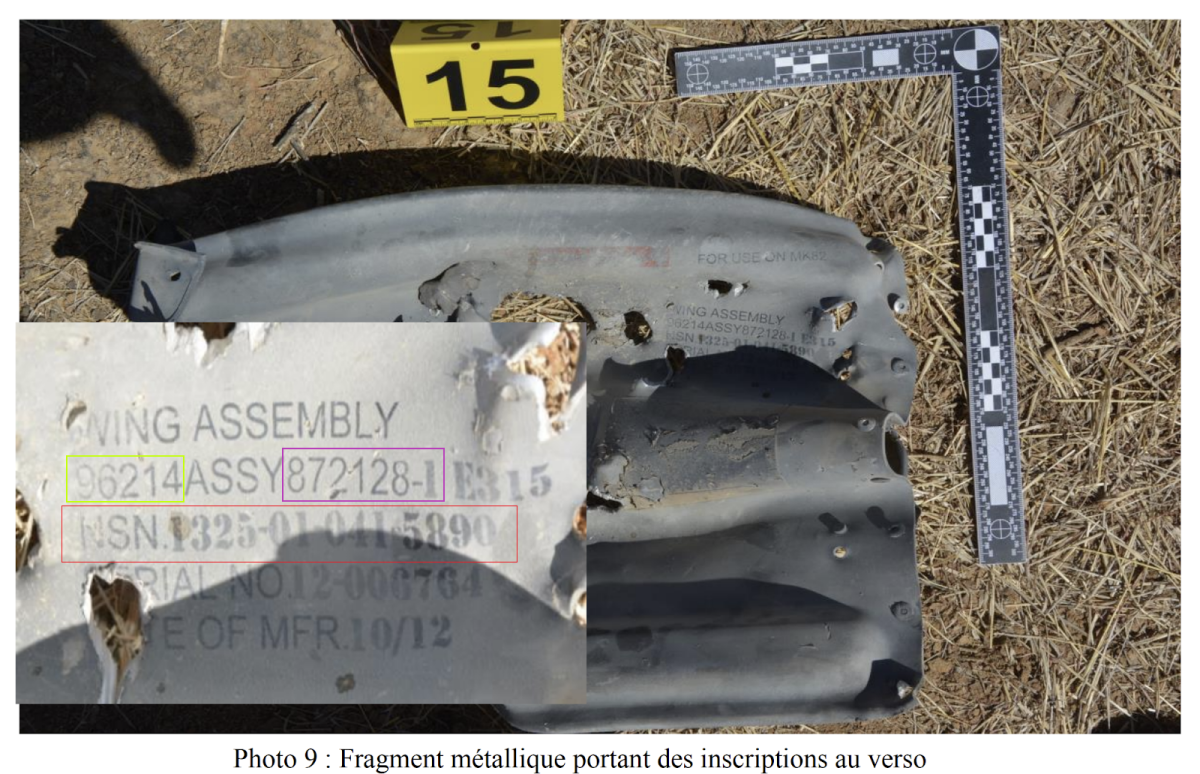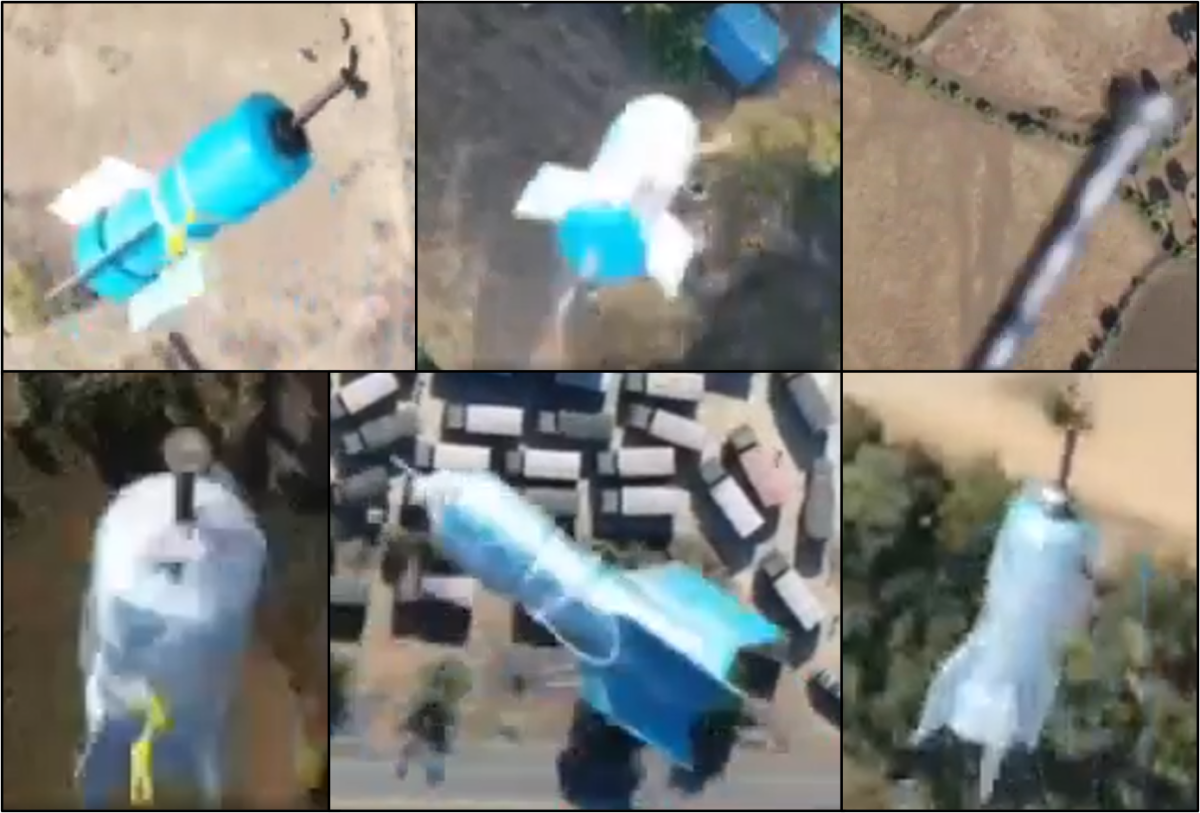Sentinels, Saeqehs and Simorghs: An Open Source Survey of Iran’s New Drone in Syria
The complexity of the Syrian conflict reached a new point with renewed attacks on Syrian and alleged Iranian military targets in Syria, the shooting down of an Israeli F-16 by the Syrian Arab Army, and the downing of Iranian drone crossing into Israeli airspace. The latter showed a particularly interesting new detail regarding Iran’s military capabilities and technologies deployed inside Syria.
Original footage showing #Iranian UAV infiltrating and then shot down over Israel, and #IDF strike on Iranian command vehicle in #Syria pic.twitter.com/Sz6poAOdjc
— Jonathan Conricus (@LTCJonathan) February 10, 2018
On footage released by the Israeli Defence Forces (IDF), an Apache AH-64 helicopter camera is tracking a low-flying drone, right before it switches to the kill view that shows how the drone is targeted and shot down.
While looking at the images, the triangular shape of the drone does not seem to match any of the known versions of Iranian drones operated in Syria. When pointed to the triangular shape of the drone, Michael Cruickshank suggested it could be the drone modelled after a captured U.S. RQ-170 Sentinel drone. The Iranian copy is known as the ‘Saeqeh’ drone and displayed on Iranian television in November 2014.
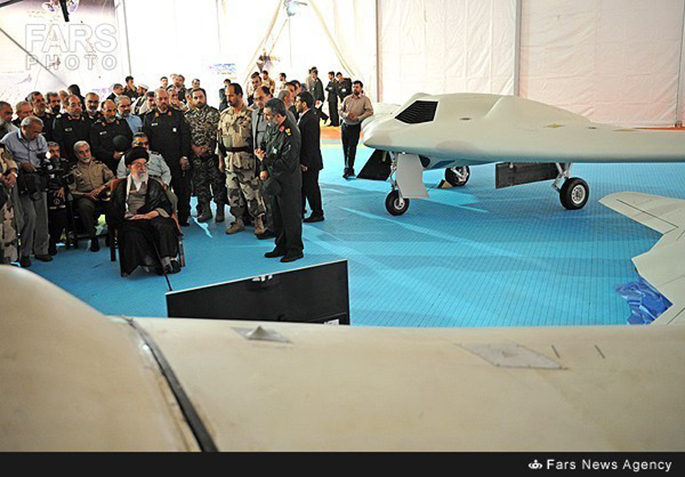
IDF spokesperson Lt. Col. Jonathan Conricus later confirmed to CNN that the drone was indeed based on the RQ-170.
According to Iranian military commanders during an interview in 2014, Saeqeh drones were developed with technology obtained from reverse-engineering the RQ-170 Sentinel, a U.S. spy drone which was captured by Iran in 2011.
However, apart from the shape there is no proof Iran has been able to actually reverse engineer the technology. It is unclear how the Sentinel crashed or if it was brought down, but it does appear the drone stayed intact and provided Iran with valuable insights in its design and components. David Cenciotti discusses what may have happened to the RQ-170 in this 2016 The Aviationist article.
The current event with the Iranian drone shot done on the Golan Heights would be a good moment to see what information we have available through open sources to find out what kind of drone this is, and what drones have been previously put on display by various media sources.
Iranian Media Reports on the Sentinel and the Saeqeh
The first source is a broadcast by the Iranian news channel Sima News from Nov. 12, 2014. According to the description in the YouTube video of the broadcast, Iranian military commanders explain that the model shown in the video is a downgraded version of the RQ-170, with its scale 60% of the original one. However, it is unclear whether the drone discussed is the same drone that is seen flying in the shown footage, as the later had different modifications with the air intake.
The RQ-170 has an estimated wingspan of 20 meters, meaning the drone seen flying in the news item is supposed to have a 12-meter wingspan. Another news item by Press TV also has footage of the drone flying.
Two years after this broadcast, in 2016, the Islamic Revolutionary Guard Corps (IRGC) announced that they had developed the “Saeqeh” (Farsi for “Thunderbolt”) UAV, a combat-drone based on the RQ-170.
The news item also showed what is supposed to be a hanger with at least ten Saeqeh’s lined up. The drone is supposed to be part of the “Simorgh” class, named after a mythical Iranian bird akin to the Phoenix.
One expert told Defense News that: “There are two copies that Iran made out of the RQ-170. One is Shahed 171, and this is supposed to be jet powered and for reconnaissance missions. Then there is the other variant of this vehicle — similar in design to RQ-170, with a piston engine and a propeller.”
Based on the video description, various sizes of the Saeqeh drones have been tested. Yet only one version has been spotted flying on open source footage. Currently, there seem to be three versions: two versions of the smaller size Saeqeh, with different air intakes, and the larger version called the Shahed-171 Simorgh with additional modifications next to the air intake, which has a jet-engine.
Making Sense with Measurents
On Nov. 11, the IDF posted an infographic on Twitter with more details, stating that the drone was indeed a copy of the RQ-170, detailing that the wingspan is 85 feet, which is roughly 26 meters. This seems to be a bigger version than the one displayed flying in the video from 2014. But is this correct? We can use the measurement from the RQ-170 to get to the wingspan of the Iranian UAV modelled after it.
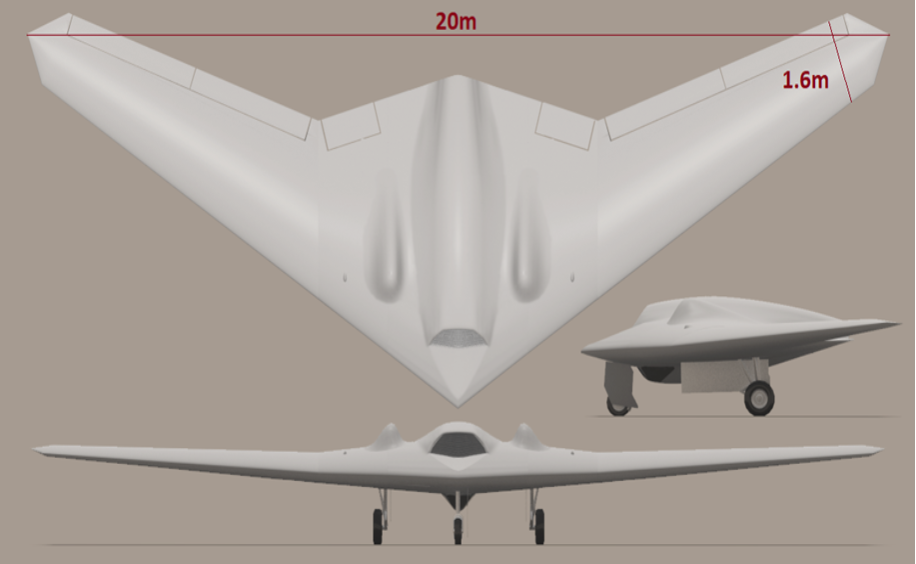
The original RQ-170 has a wingspan of 20m and a wingtip width of 1.6.m. From these dimensions it is possible to determine an approximate wingspan to wingtip width ratio of 12.5:1. Assuming that the broad design of the RQ-170 applies to the Iranian drone, images of the wing tips can be used to calculate its wingspan
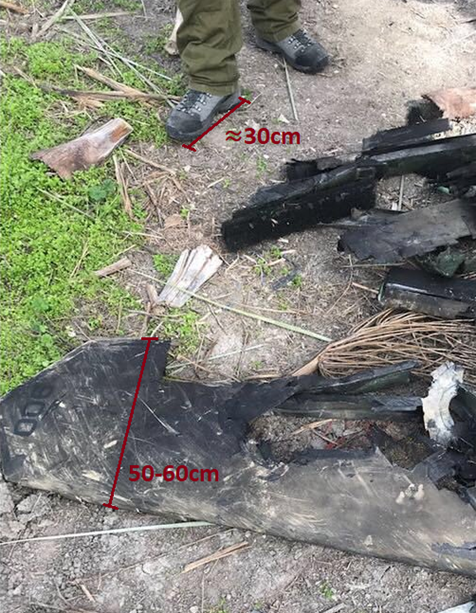
Measurements of the wing compared with foot size shown on a photo published by the IDF.
From this image released by the IDF of the wreckage of the Iranian drone, a wingtip width of between 50-60cm can be approximated using the shoe in the frame as a reference point. Such a length would make the drone have a wingspan of 6.25-7.5m based on this 12.5:1 ratio.
Hence the IDF statement of the Iranian version to be 26 meters wide seems to be an overstatement if the footage of the wreckage being put online is to go by. More precise data on the drone is needed to very the IDF claim.
Comparing Wings and Components
Other pictures of the downed drone posted by the IDF helps us identify the version of the drone shot down by the Apache. On the image below, one can clearly see the wing shape of the drone similar to the wing shape of the drone in the footage from 2016 video.
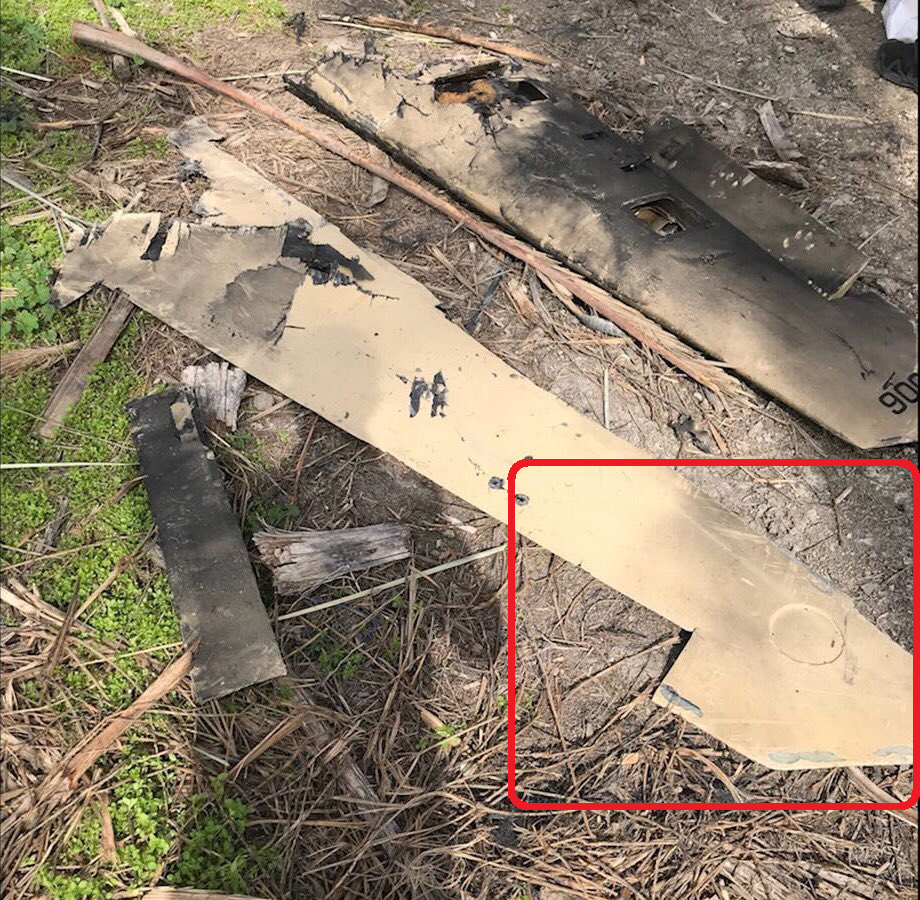
Wing tip of Iranian drone shown on a photo published by the IDF.
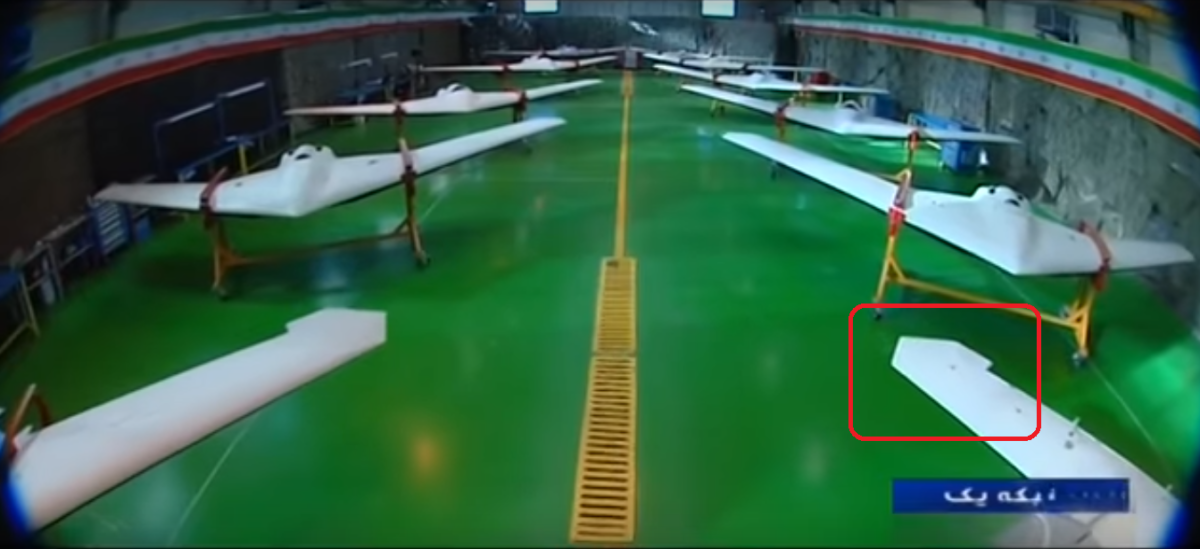
Line-up of 10 Saeqehs in a hangar in Iran. Location unknown.
The images of the downed drone and those put on display for Iranian TV seem to be different version compared with the drone seen flying, which has a different wing shape, though this can also be due to the flaps being up. Nonetheless, there are some other striking differences.
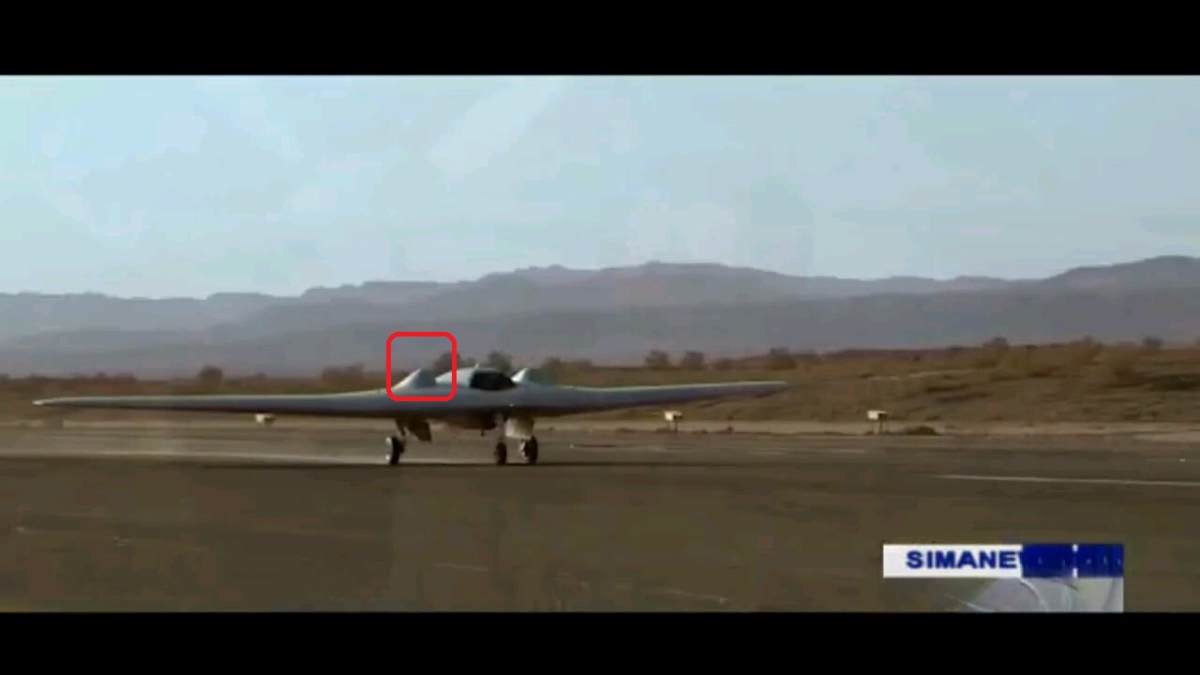
The drone in the image above is also larger and has an upper engine intake, compared with the smaller one displayed in the hangar, though two of those on display in the hangar have larger exhaust intakes as well, yet are missing the elevated parts on both side next to the exhaust as seen in the footage of the flying drone.
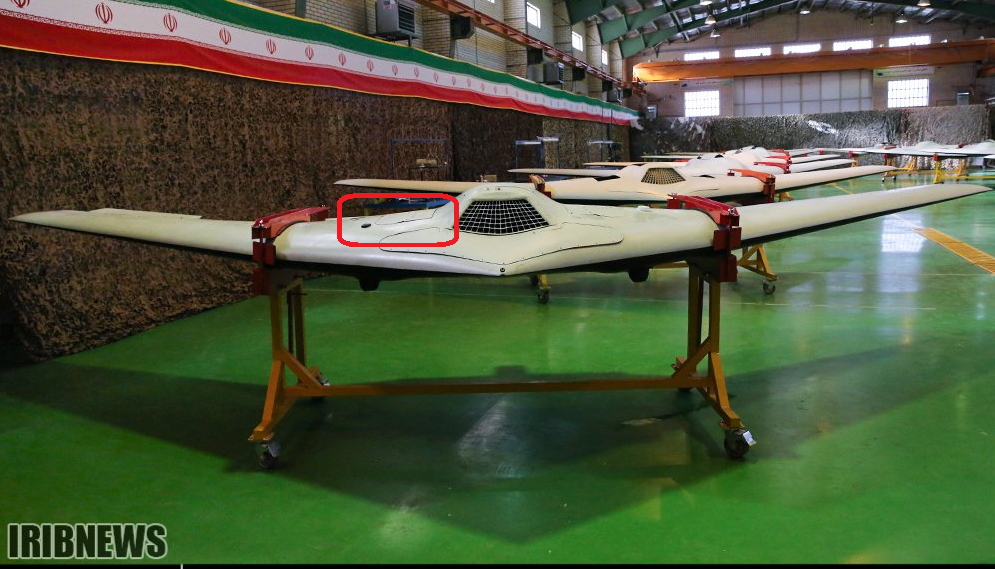
The footage before the killshot also indicates that this drone has a piston engine, as a propeller seems to be visible on the footage, though it’s not entirely certain.
If this is correct, that entails that the current version shot down by the IDF is not the jet-engine Shahed S-171 Simorgh drone shown on the footage released by Iranian media outlets.
Twitter users @border9999 and @reutersanders provided information on a military airport east of Tehran, base where similar V-shaped drones were visible on Google Earth from 20 October 2013. These versions have a wingspan of 10 meters, though it’s not clear from the images if those were mock-ups or drones that were able to fly.
don't know the dimension of the Iranian Saeghe #Drone – but here are some 10m (wing) Drones seen in Teheran pic.twitter.com/vimu8gwNkq
— rambo54 (@reutersanders) February 12, 2018
Summing up, there are now three known version of batwing model: two different versions of the Saeqeh and a larger version dubbed the S-171 Samorgh, where the latter is seen flying in Iranian state TV footage.

More Drone Wars?
Another interesting detail in the IDF communication is the reference to the Shaer-129 armed drone, which is pictured in Israeli aerial surveillance footage shared by the IDF Twitter account. It shows the Shaer-129 at the T-4 Airbase west of Palmyra, outside the hangar which is geo-located at this is particular site on the airbase
An aerial image published by the IDF shows a Shaer-129 drone at the T-4 Military Air Base in Syria’s Homs province.
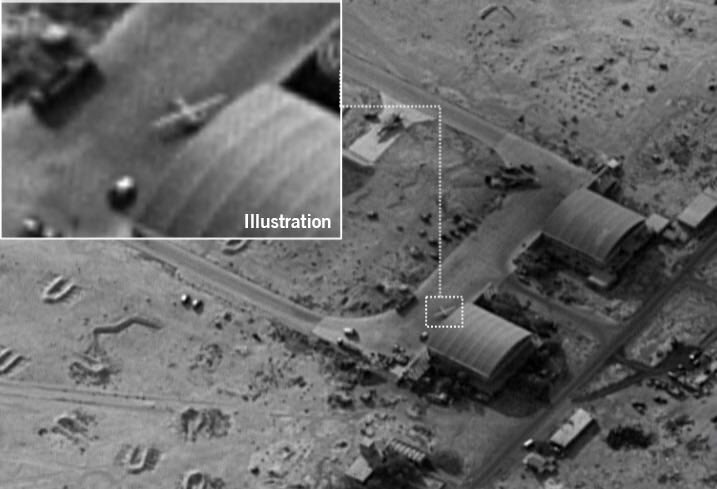
Footage by IDF of an alleged Shaer-129 drone at the T-4 Air Base.
Geolocated hangar at the T-4 Military Air Base in Syria’s Homs province.
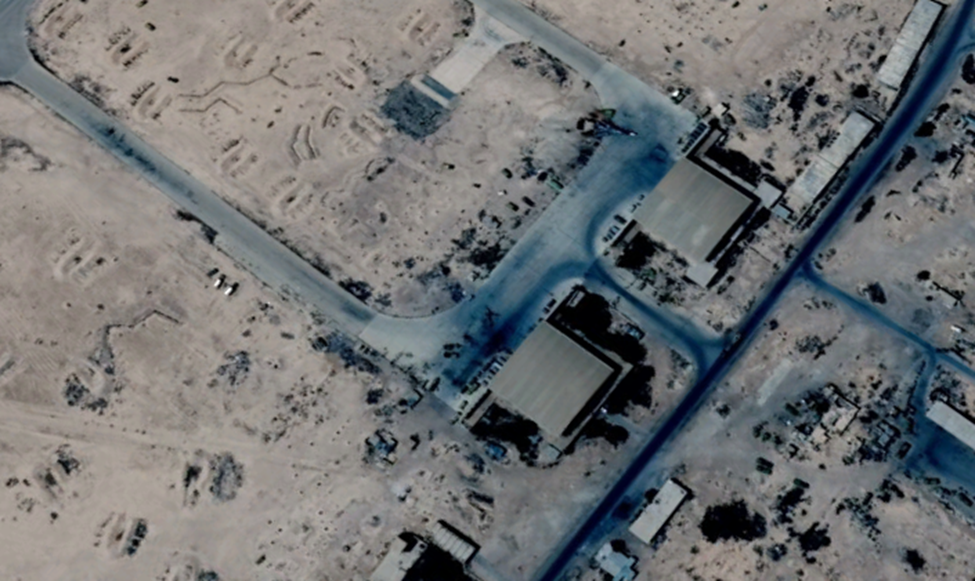
Google Earth Image of the T-4 Air Base, Syria.
Ever since they got involved in the Syrian war (following a request of the Syrian government), the IRCG has experimented with various types of unarmed intelligence, surveillance, targeting and reconnaissance drones, and later on also armed versions. Their battlefield tested use could improve Iran’s commercial position for competing on the drone market in countries they have trade relations with, either by sales or export of knowledge on how to build these types of combat drones.
Failed Clone or Propaganda Drone?
As previously indicated by other authors, there are the usual caveats when it comes to drones put on display, such as its actual combat capable version. Not everything is necessarily what it appears to be – so it is with these Iranian drones.
There can be great propaganda value to overstating one’s military capabilities, be it inflatable Russian jet fighters or putting up relatively small drone models with relatively large, unknown type of missiles in the case of the Iranian TV footage, which has all the appearances of a mock-up version.
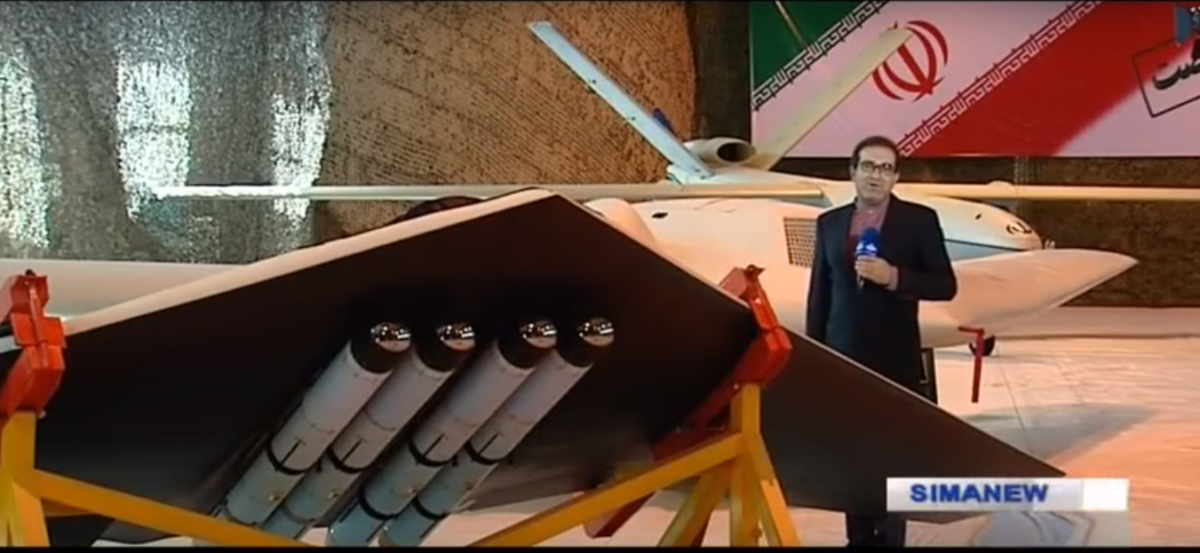
Another version of the Saeqeh with four unknown missile types, October 2016.
“It doesn’t [appear to] have stealth tactics,” said Rodger Shanahan, a research fellow at the Lowy Institute for International Policy, to CNN about the Iranian drone. “It might show that all they’ve done is create a better drone than they did before, maybe that was the point they were trying to test out.”
Yet, it’s easy to underestimate the capabilities of any military force. Appearing weaker could also be tactic to mislead the enemy.
Syria as Testing Ground for Drones
With the current pace of technological developments, many armed forces and non-state armed groups have steep learning curves when it comes to drone technology, and there are likely more surprises waiting in the near future.
Syria has proven to be a useful testing ground for States experimenting with drones and drone-related equipment. Examples include: the deployment of a new precision rocket by allegedly a US drone strike, Hezbollah and the so-called Islamic State massive deployment of commercial drones, Iran’s use of armed and ISR Shahed 129 drones in targeting missions and strikes, Russia flying over eighty drones in support of their military operations, and swarms of home-build drones equipped with grenades by Syrian armed groups against the airbase hosting Russian fighter jets at Hmeimim Air Base.
This blog was a collaborative effort with Michael Cruickshank (@MJ_Cruickshank) who did the measurements based on IDF footage, Christiaan Triebert (@trbrtc) and with additional support from Adam Rawnsley (@arawnsley), Foeke Postma (@foekepostma) and “Samir” (@obretix).

